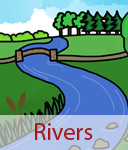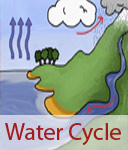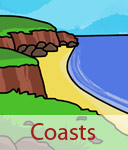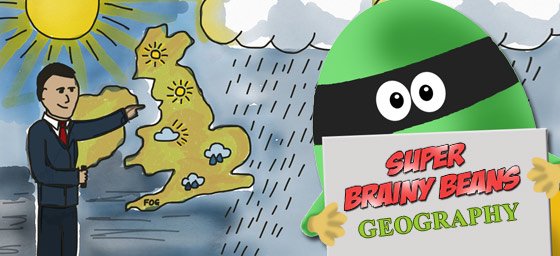
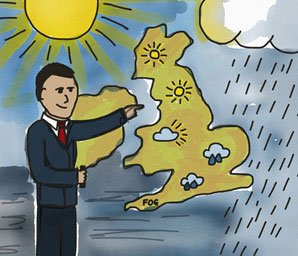
UK Weather for kids
UK Weather for kids at Primary School KS1 & KS2. Primary homework help with what makes our weather, how we measure the temperature, wind and rain.
What is weather?
Weather is what happens in the atmosphere—the blanket of air that surrounds our planet. It’s everything we feel and see in the sky each day. Weather controls whether the day is sunny and bright, cloudy and grey, rainy and wet, or even snowy and icy.
Weather also changes how warm or cold the air feels. On some days the sun heats up the ground and makes us feel hot, while on other days chilly winds or frosty mornings make us reach for our coats and scarves.
The weather is always changing—sometimes slowly, sometimes suddenly. That’s why the UK can have sunshine one moment and heavy rain the next! Over a whole year, these changes happen in patterns we call the seasons: spring, summer, autumn, and winter.
What makes the weather hot or cold?
The Earth isn’t standing straight up and down. Instead, it’s tilted at an angle of about 23.5°. This tilt means that during the year, different parts of the Earth lean either towards or away from the Sun.
- Summer: In summer, the UK is tilted towards the Sun. The Sun’s rays hit us more directly and stay in the sky for longer each day. This makes the days warmer and gives us more daylight hours.
- Winter: In winter, the UK is tilted away from the Sun. The rays are weaker, spread out more, and the days are shorter. This is why it feels colder and we have less daylight.
- Spring and Autumn: These are the times in between, when the tilt is changing and the days and nights are about the same length. The temperatures are usually mild.
That’s why we have warm summers and cold winters, even though the Sun itself doesn’t move closer or farther away.
How do we measure the temperature?
The temperature tells us how hot or cold the air is, and we measure it using a tool called a thermometer.
A traditional thermometer is a hollow glass tube with a little bulb at the bottom. Inside the bulb is a liquid, often mercury or sometimes colored alcohol. When the air around the thermometer gets hotter, the liquid expands and rises up the tube. When the air gets colder, the liquid contracts and moves back down. The point where the liquid stops shows the temperature.
Today, we also have digital thermometers, which use electronic sensors instead of liquid. These are often easier to read and can measure the temperature very accurately.
In weather reports, temperatures are usually measured in degrees Celsius (°C) in the UK. For example:
- A hot summer day might be 25°C.
- A chilly winter day might be only 2°C.
- Water freezes at 0°C and boils at 100°C.
- The UK's hottest temperature ever recorded was 40.3°C in Lincolnshire, white the coldest was -27.2°C in Aberdeenshire.
- The world’s hottest temperature ever recorded on Earth was 56.7°C in Death Valley, USA, while the coldest was -89.2°C in Antarctica!
 Weather Wizkids
Weather WizkidsTemperature explained. Wind Chill Index explained. Understand the temperature fully.
Why does it rain?
Rain is part of something called the water cycle. The water cycle explains how water moves around our planet.
- Evaporation – Heat from the Sun warms up seas, lakes, and rivers. This turns water into water vapour (a gas), which rises into the sky.
- Condensation – As the water vapour rises, the air gets cooler. The vapour changes back into tiny water droplets, which group together to form clouds.
- Precipitation – When the clouds get too heavy with water droplets, the water falls back down to Earth as rain.
- Collection – The rainwater collects in rivers, lakes, and seas, and the whole cycle begins again.
This process is happening all the time, which is why the weather is always changing!
Types of rain in the UK
The UK is famous for its rainy weather, but not all rain is the same! Here are some of the different types you might see:
- Drizzle – Light rain with tiny droplets. It feels damp and misty rather than heavy.
- Showers – Short bursts of rain that can start and stop suddenly.
- Downpour – Very heavy rain that falls quickly and can cause puddles or floods.
- Hail – Small balls of ice that fall from the sky during thunderstorms. They can be as tiny as peas or as big as golf balls!
- Snow – Frozen water crystals that fall when the air is very cold. Snowflakes are all unique in shape.
- Sleet – A mix of rain and snow together, usually falling on very cold days.
 Weather Wizkids
Weather WizkidsUnderstand how the water cycle works with our facts that help explain the different processes in a way that is easy to follow.
What makes wind?

The simple answer is: the Sun makes the wind!
Here’s how it works:
- The Sun heats up the Earth’s surface (land and sea).
- The air above the warm ground or water also gets heated.
- Warm air rises because it is lighter than cool air.
- As the warm air moves upwards, cooler, heavier air rushes in to take its place.
- That movement of air is what we feel as wind.
The strength of the wind depends on how big the difference is between the hot and cold air. If the air temperature changes a lot, the wind can be very strong, even reaching storm levels. If the difference is small, you only feel a gentle breeze.
Wind doesn’t just move in small areas. Because the Earth is always turning, and the Sun heats different parts of the planet unevenly, wind can travel over huge distances. That’s why we have global winds like the trade winds and jet streams, which move weather systems all around the world.
How do we measure wind speed?
To find out how fast the wind is blowing, scientists use a tool called an anemometer.
- An anemometer usually has three or four cups attached to arms at the top.
- When the wind blows, it pushes the cups around in circles.
- The stronger the wind, the faster the cups spin.
- A little computer or dial measures how quickly the cups are moving and shows the wind speed, usually in miles per hour (mph) or kilometres per hour (km/h).
There are also more modern anemometers that use lasers or sound waves instead of cups, but they all do the same job: measuring how fast the wind is moving.
Beaufort scale
Another way to describe wind speed is by using the Beaufort Scale. This scale was invented over 200 years ago by a man called Sir Francis Beaufort, who worked in the Royal Navy. Instead of just giving numbers, the Beaufort Scale explains what wind feels like on land or looks like at sea.
| Beaufort scale | Description | Conditions |
|---|---|---|
| 0 | Calm | Calm. Smoke rises vertically. |
| 1 | Light air | Smoke drift indicates wind direction. Leaves and wind vanes are stationary. |
| 2 | Light breeze | Wind felt on exposed skin. Leaves rustle. Wind vanes begin to move. |
| 3 | Gentle breeze | Leaves and small twigs constantly moving, light flags extended. |
| 4 | Moderate breeze | Dust and loose paper raised. Small branches begin to move. |
| 5 | Fresh breeze | Branches of a moderate size move. Small trees in leaf begin to sway. |
| 6 | Strong breeze | Large branches in motion. Whistling heard in overhead wires. Umbrella use becomes difficult. Empty plastic bins tip over. |
| 7 | High wind, moderate gale, near gale | Whole trees in motion. Effort needed to walk against the wind. |
| 8 | Gale, fresh gale | Some twigs broken from trees. Cars veer on road. Progress on foot is seriously impeded. |
| 9 | Strong/severe gale | Some branches break off trees, and some small trees blow over. Construction/temporary signs and barricades blow over. |
| 10 | Storm, whole gale | Trees are broken off or uprooted, structural damage likely. |
| 11 | Violent storm | Widespread vegetation and structural damage likely. |
| 12 | Hurricane force | Severe widespread damage to vegetation and structures. Debris and unsecured objects are hurled about. |
The Beaufort Scale is still used today by sailors, weather forecasters, and even walkers to help describe the strength of the wind.
How strong is the wind?
Go outside and feel the wind. Look at the trees, flags, or how it feels on your face. Then check the Beaufort Scale table, what number would you give the wind today?


